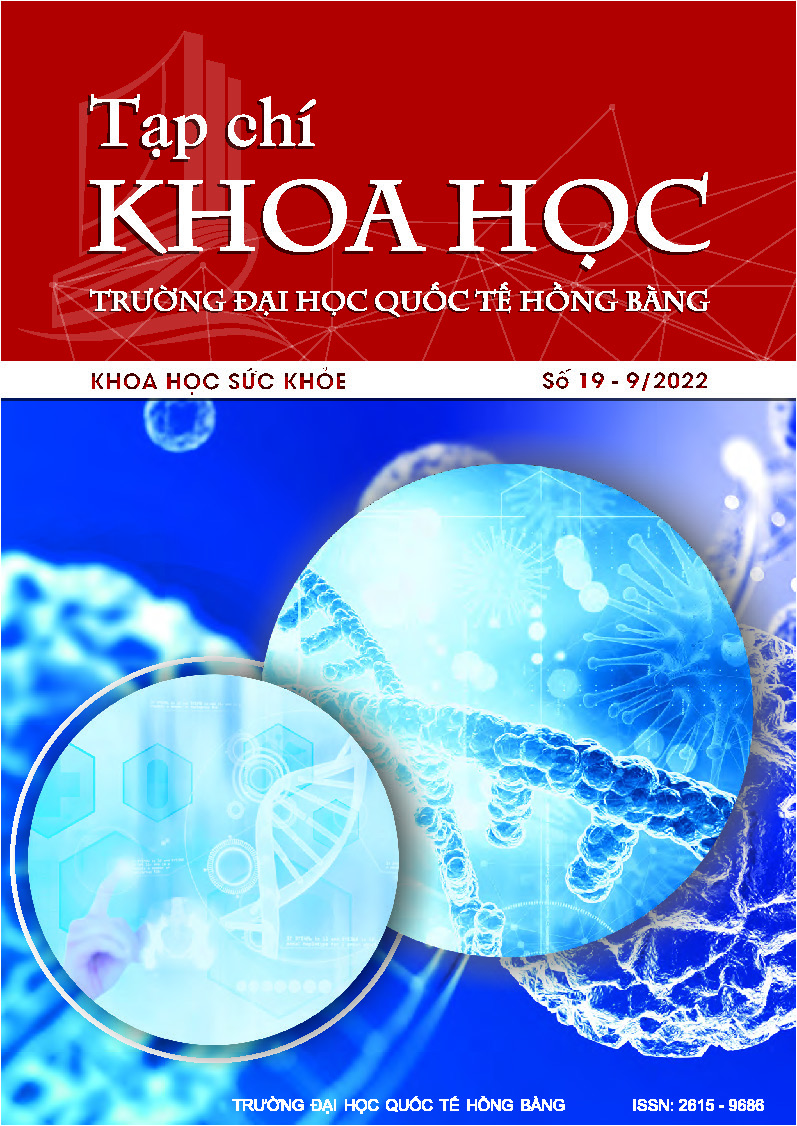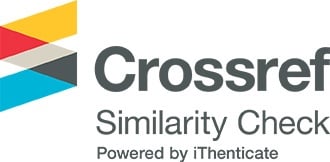Tác dụng ức chế α-glucosidase và kháng oxy hóa in vitro của các cao chiết phối hợp từ chùm ngây (Moringa oleifera), lá đắng (Vernonia amygdalina) và rau má (Centella asiatica)
Các tác giả
Từ khóa:
chùm ngây, lá đắng, kháng oxy hóa, ức chế α-glucosidase, rau máTóm tắt
Nghiên cứu này khảo sát tác dụng ức chế α-glucosidase và kháng oxy hóa in vitro của các công thức phối hợp từ lá cây chùm ngây, lá cây lá đắng và rau má. Kết quả cho thấy công thức được phối từ cao chiết ethanol 45% riêng lẻ ở tỷ lệ 1 chùm ngây: 1 lá đắng: 3 rau má có tác dụng ức chế α-glucosidase tốt hơn các công thức phối hợp khác và cũng có khả năng kháng oxy hóa theo cơ chế bắt gốc tự do DPPH với giá trị IC50 lần lượt là 275.12 µg/mL và 110.69 µg/mL. Công thức phối hợp này thể hiện tương tác hiệp đồng ở cả tác dụng ức chế α-glucosidase và bắt gốc tự do DPPH. Vì vậy, công thức phối hợp tối ưu này cần được tiếp tục nghiên cứu trên các tác dụng dược lý in vivo để phát huy các đặc tính dược lý tốt của cả ba dược liệu này.
Abstract
This study investigated the in vitro α-glucosidase inhibitory and antioxidant properties of combined formulas of Moringa oleifera (MO), Vernonia amygdalina (VA), and Centella asiatica (CA) leaves. The results showed that the formula mixed from the single 45% ethanol extracts at the ratio of 1MO: 1VA: 3CA had better α-glucosidase inhibitory activity than other formulations and also had antioxidant capacity by DPPH free radical scavenging mechanism with an IC50 value of 275.12 µg/mL and 110.69 µg/mL, respectively. This combined formula exhibited synergistic interactions in both α-glucosidase inhibition and DPPH free radical scavenging. Therefore, the optimal combination formula should be further studied on in vivo pharmacological activities to promote the good pharmacological properties of three medicinal herbs.
Tài liệu tham khảo
[1] R. Goyal and I. Jialal, “Diabetes mellitus type 2”, In StatPearls [Internet]. Treasure Island (FL): StatPearls Publishing, 2020, Available from: https://www.ncbi.nlm.nih.gov/books/NBK513253/.
[2] U. F. Magaji, O. Sacan and R. Yanardag, “Alpha amylase, alpha glucosidase and glycation inhibitory activity of Moringa oleifera extracts,” South African Journal of Botany, Vol. 128, pp. 225-230, 2020. DOI: 10.1016/j.sajb.2019.11.024
[3] H. L. T. Anh, L. B. Vinh, L. T. Lien, … Y. H. Kim, “In vitro study on α-amylase inhibitory and α-glucosidase of a new stigmastane-type steroid saponin from the leaves of Vernonia amygdalina,” Natural Product Research, Vol. 35, No. 5, pp. 873-879, 2019. DOI: 10.1080/ 14786419.2019.1607853
[4] V. Mehta, A. Sharma, S. Tanwar and U. Malairaman, “In vitro and in silico evaluation of the antidiabetic effect of hydroalcoholic leaf extract of Centella asiatica,” International Jounal Pharmacy and Pharmaceutical Sciences, Vol. 8, No. 8, pp. 357-362, 2016.
[5] A. Bhattacharya, P. Tiwari, P. K. Sahu and S. Kumar, “A review of the phytochemical and pharmacological characteristics of Moringa oleifera,” Journal of Pharmacy & Bioallied Sciences, Vol. 10, No. 4, pp. 181-191, 2018. DOI: 10.4103%2FJPBS.JPBS_126_18
[6] K. Y. Swee, Y. H. Wan, K. B. Boon, … B. A. Noorjahan, “Vernonia amygdalina, an ethnoveterinary and ethnomedical used green vegetable with multiple bio-activities,” Journal of Medicinal Plants Research, Vol. 4, No. 25, pp. 2787-2812, 2010.
[7] D. C. Roy, S. K. Barman and M. M. Shaik, “Current updates on Centella asiatica: Phytochemistry, pharmacology and traditional uses,” Medicinal Plant Research, Vol. 3, No. 4, pp. 20-36, 2013.
[8] E. E. A. Hisam, M. S. Rofiee, A. M. Khalid, … M. Z. Salleh, “Combined extract of Moringa oleifera and Centella asiatica modulates oxidative stress and senescence in hydrogen peroxide-induced human dermal fibroblasts,” Turkish journal of biology, Vol. 42, No. 1, pp. 33-44, 2018. DOI: 10.3906/biy-1708-23.
[9] E. E. Efiong, G. O. Igile, B. I. A. Mgbeje, E. A. Out and P. E. Ebong, “Hepatoprotective and anti-diabetic effect of combined extracts of Moringa oleifera and Vernonia amygdalina in streptozotocin-induced diabetic albino Wistar rats,” Journal of Diabetes and Endocrinology, Vol. 4, No. 4, pp. 45-50, 2013. DOI: 10.5897/JDE2013.0069.
[10] N. T. T. Huong, N. H. Minh and N. T. M. Anh, “Effects of a preparation from Moringa oleifera leaves (Moringa capsules) in diabetic mice,” Journal of Medicinal Materials, Vol. 23, No. 3, pp. 171-179, 2018.
[11] D. T. Mong and N. T. T. Huong, “Effects of aqueous and ethanol extracts from Vernonia amygdalina leaves on blood glucose level and oxidative stress in streptozotocin-induced diabetic mice,” Journal of Medicinal Materials, Vol. 24, No. 3, pp. 168-174, 2019.
[12] M. T. Chung và N. T. T. Hương, “Khảo sát tác dụng của cao chiết cồn từ Rau má (Centella asiatica) trên mô hình gây suy giảm trí nhớ bằng D-galactose,” Tạp chí Y học TP. Hồ Chí Minh, Vol. 21, No. 6, pp. 169-174, 2017.
[13] L. H. Trieu, L. V. Minh and N. T. T. Huong, “In vitro α-amylase and α-glucosidase inhibitory activities of crude and fractionated extracts of Clerodendrum inerme leaves collected from Phu Quoc Island,” Journal of Medicinal Materials, Vol. 23, No. 5, pp. 283-289, 2018.
[14] H. T. Ly, T. T. H. Nguyen, T. T. L. Tran, … V. M. Le, “Hypoglycemic and antioxidant activities of Clerodendrum inerme (L.) Gaertn. leaf extract on streptozotocin-induced diabetic models in mice,” Chinese herbal medicines, Vol. 11, No. 4, pp. 387-393, 2019. DOI: 10.1016/j.chmed. 2019.08.001.
[15] J. Gao, P. Xu, Y. Wang, Y. Wang and D. Hochstetter, “Combined effects of green tea extracts, green tea polyphenols or epigallocatechin gallate with acarbose on inhibition against α-amylase and α-glucosidase in vitro,” Molecules, Vol. 18, No. 9, pp. 11614-11623, 2013. DOI: 10.3390/molecules 180911614.
[16] T. C. Chou and P. Talalay P, “Quantitative analysis of dose-effect relationships: the combined effects of multiple drugs or enzyme inhibitors,” Advances in Enzyme Regulation, Vol. 22, pp. 27-55, 1984. DOI: 10.1016/0065-2571(84)90007-4.
[17] F. Giacco and M. Brownlee, “Oxidative stress and diabetic complications,” Circulation research, Vol. 107, No. 9, pp. 1058-1070, 2010.
[18] G. Karthivashan, M. T. Fard, P. Arulselvan, F. Abas and S. Fakurazi, “Identification of bioactive candidate compounds responsible for oxidative challenge from hydro-ethanolic extract of Moringa oleifera leaves,” Jouranl of Food Science, Vol. 78, No. 9, pp. 1368-1375, 2013. DOI: 10.1111/1750-3841.12233.
[19] R. Taweerutchana, N. LumLerdkij, S. Vannasaeng, P. Akarasereenont and A. Sriwijitkamol, “Effect of Moringa oleifera leaf capsules on glycemic control in therapy-naïve type 2 diabetes patients: A randomized placebo controlled study,” Evidnece-Based Complementary and Alternative Medicine, Vol. 2017, ID Article 6581390, 2017. DOI: 10.1155/2017/6581390.
[20] P. Anthanont, N. LumLerdkij, P. Akarasereenont, S. Vannasaeng and A. Sriwijitkamol, “Moringa oleifera leaf increases insulin secretion after single dose administration: A preliminary study in healthy subjects,” Journal of The Medical Association of Thailand, Vol. 99, No. 3, pp. 308-313, 2016.
[21] R. T. Dewi and F. Maryani, “Antioxidant and α-glucosidase inhibitory compounds of Centella asiatica,” Procedia Chemistry, Vol. 17, No. 2015, pp. 147-152, 2015. DOI: 10.1016/j.proche.2015.12.130.
[22] N. Supkamonseni, A. Thinkratok, D. Meksuriyen and R. Srisawat, “Hypolipidemic and hypoglycemic effects of Centella asiatica (L.) extract in vitro and in vivo,” Indian Journal of Experimental Biology, Vol. 52, No. 10, pp. 965-971, 2014.
[23] P. Rameshreddy, V. V. S. Uddandrao, P. Brahmanaidu, … G. Saravanan, “Obesity-alleviating potential of asiatic acid and its effects on ACC1, UCP2, and CPT1 mRNA expression in high fat diet-induced obese Sprague-Dawley rats,” Molecular and Cellular Biochemistry, Vol. 442, No. (1-2), pp. 143-154, 2018. DOI: 10.1007/s11010-017-3199-2.
[24] O. R. Alara and N. H. Abdurahman, Anti-diabetic activity and mineral elements evaluation of Vernonia amygdalina leaves obtained from Malaysia,” Journal of Research in Pharmacy, Vol. 23, No. 3, pp. 514-521, 2019. DOI: 10.12991/jrp.2019.158.
[25] J. A. Saliu, A. O. Ademiluyi, A. J. Akinyemi and G. Oboh, “In vitro antidiabetes and antihypertension properties of phenolic extracts from bitter leaf (Vernonia amygdalina Del.),” Journal of Food Biochemistry, Vol. 36, No. 5, pp. 569-576, 2011. DOI: 10.1111/j.1745-4514.2011.00576.x.
[26] Y. Meng, Z. Du, Y. Li, … X. Guo , “The synergistic mechanism of total saponins and flavonoids in Notoginseng-Safflower pair against myocardial ischemia uncovered by an integrated metabolomics strategy,” Biomedecine Pharmacother, Vol. 130, 110574, 2020. DOI:10.1016/j.biopha.2020.110574.
[27] M. Li, Y. Xu, W. Yang, … D. Li, “In vitro synergistic anti-oxidant activities of solvent-extracted fractions from Astragalus membranaceus and Glycyrrhiza uralensis,” Food Science and Technology, Vol. 44, No. 8, pp. 1745-1751, 2011. DOI: 10.1016/j.lwt.2011.02.017.
Tải xuống
Tải xuống: 219







